初中英语八大时态语态总复习时态讲解
中考英语八种时态知识点归纳
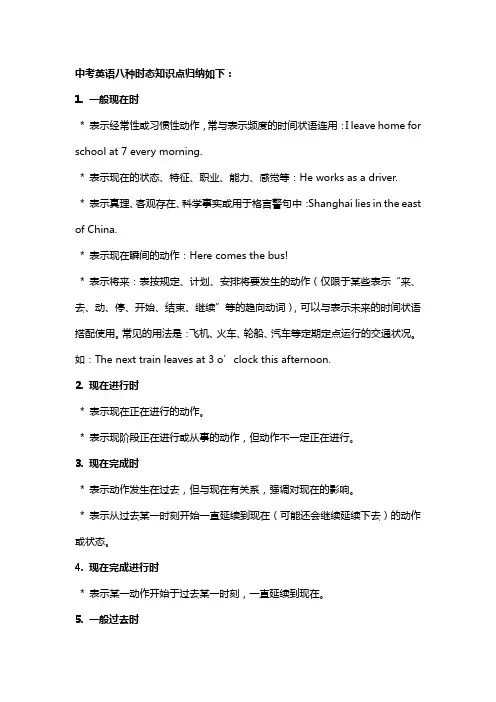
中考英语八种时态知识点归纳如下:1. 一般现在时* 表示经常性或习惯性动作,常与表示频度的时间状语连用:I leave home for school at 7 every morning.* 表示现在的状态、特征、职业、能力、感觉等:He works as a driver.* 表示真理、客观存在、科学事实或用于格言警句中:Shanghai lies in the east of China.* 表示现在瞬间的动作:Here comes the bus!* 表示将来:表按规定、计划、安排将要发生的动作(仅限于某些表示“来、去、动、停、开始、结束、继续”等的趋向动词),可以与表示未来的时间状语搭配使用。
常见的用法是:飞机、火车、轮船、汽车等定期定点运行的交通状况。
如:The next train leaves at 3 o’clock this afternoon.2. 现在进行时* 表示现在正在进行的动作。
* 表示现阶段正在进行或从事的动作,但动作不一定正在进行。
3. 现在完成时* 表示动作发生在过去,但与现在有关系,强调对现在的影响。
* 表示从过去某一时刻开始一直延续到现在(可能还会继续延续下去)的动作或状态。
4. 现在完成进行时* 表示某一动作开始于过去某一时刻,一直延续到现在。
5. 一般过去时* 表示过去某个时间发生的动作或存在的状态。
* 表示过去经常或反复发生的动作。
6. 过去进行时* 表示在过去某一时刻或某一段时间正在进行的动作。
7. 过去完成时* 表示在过去某一时刻之前已经完成或结束的动作或状态。
8. 一般将来时* 表示将来某个时间要发生的动作或存在的状态。
* 表示将来经常或反复发生的动作。
以上就是中考英语中常见的八种时态,希望对你有所帮助。
初中英语必考八大时态结构及用法详解

初中英语必考八大时态结构及用法详解英语八大时态:1一般现在时标志:动词原形或三单线1. 表示经常性或习惯性动作,常与表频度的时间状语连用:She often speaks English.I leave home for school at 7 every morning.2. 表示现在的状态、特征、职业、能力、感觉等:He seems to feel a bit down today.He works as a driver.3. 表示真理、客观存在、科学事实或用于格言警句中:Shanghai lies in the east of China.Columbus proved that the earth is round.Where there is a will, there is a way.4. 表示现在瞬间的动作:Here comes the bus!5. 表示将来1) 表按规定、计划、安排将要发生的动作(仅限于某些表示“来、去、动、停、开始、结束、继续”等的趋向动词),可以与表示未来的时间状语搭配使用。
常见的用法是:飞机、火车、轮船、汽车等定期定点运行的交通状况。
如:The next train leaves at 3 o’clock this afternoon.2) 在时间和条件状语从句中常使用一般现在时表示将来发生的事情:When Bill comes (不用will come), ask him to wait for me.I shall go there tomorrow unless I’m too busy.2一般过去时标志:动词过去式*闭音节:元音字母a, e, i, o, u如果发字母本来的音则称为开音节,否则称为闭音节。
1. 表示过去某时所发生的动作或存在的状态,常与表示过去的时间状语连用(e.g. yesterday, this morning, just now, a moment ago, in May, last night / year / week, once upon a time, the other day, before …, when …, in the past等)。
初中8种基本时态讲解
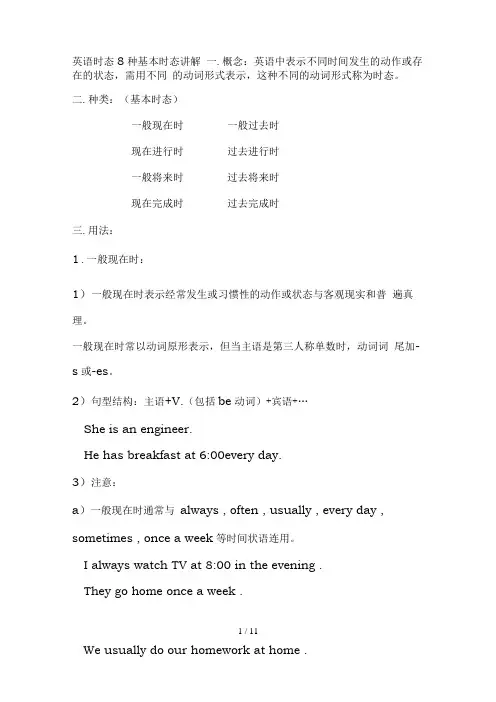
英语时态8种基本时态讲解一.概念:英语中表示不同时间发生的动作或存在的状态,需用不同的动词形式表示,这种不同的动词形式称为时态。
二.种类:(基本时态)一般现在时一般过去时现在进行时过去进行时一般将来时过去将来时现在完成时过去完成时三.用法:1.一般现在时:1)一般现在时表示经常发生或习惯性的动作或状态与客观现实和普遍真理。
一般现在时常以动词原形表示,但当主语是第三人称单数时,动词词尾加-s或-es。
2)句型结构:主语+V.(包括be动词)+宾语+…She is an engineer.He has breakfast at 6:00every day.3)注意:a)一般现在时通常与always , often , usually , every day , sometimes , once a week等时间状语连用。
I always watch TV at 8:00 in the evening .They go home once a week .1 / 11We usually do our homework at home .b)表客观现实或普遍真理。
The sun always rises in the east .The light travels faster than the sound .c)表永远性的动作或状态。
He lives in the country .4)第三人称单数变化形式。
a)一般情况动词在词尾加-s .e---es speak---speaks work-works live---lives b)以o, s, x, ch, sh结尾的单词在词后加-es.do---does go---goes finish---finishes brush---bru shesfix---fixes pass---passes watch---watchesc)以“辅音字母+y”结尾的单词变y为i加-es.Study-studies carry-carries cry---criesd)以“元音字母+y”结尾的单词直接加-s.play---plays stay---stays例句:我们每天晚上九点做作业。
初中英语时态8种基本时态讲解
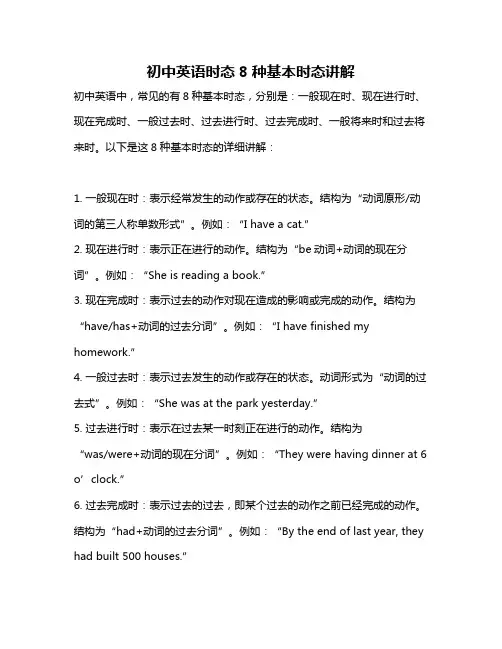
初中英语时态8种基本时态讲解初中英语中,常见的有8种基本时态,分别是:一般现在时、现在进行时、现在完成时、一般过去时、过去进行时、过去完成时、一般将来时和过去将来时。
以下是这8种基本时态的详细讲解:1. 一般现在时:表示经常发生的动作或存在的状态。
结构为“动词原形/动词的第三人称单数形式”。
例如:“I have a cat.”2. 现在进行时:表示正在进行的动作。
结构为“be动词+动词的现在分词”。
例如:“She is reading a book.”3. 现在完成时:表示过去的动作对现在造成的影响或完成的动作。
结构为“have/has+动词的过去分词”。
例如:“I have finished my homework.”4. 一般过去时:表示过去发生的动作或存在的状态。
动词形式为“动词的过去式”。
例如:“She was at the park yesterday.”5. 过去进行时:表示在过去某一时刻正在进行的动作。
结构为“was/were+动词的现在分词”。
例如:“They were having dinner at 6 o’clock.”6. 过去完成时:表示过去的过去,即某个过去的动作之前已经完成的动作。
结构为“had+动词的过去分词”。
例如:“By the end of last year, they had built 500 houses.”7. 一般将来时:表示将来要发生的动作或存在的状态。
结构为“will+动词原形”或“am/is/are going to+动词原形”。
例如:“We will visit the museum next week.”8. 过去将来时:表示从过去的某一时刻看,将来要发生的动作或存在的状态。
结构为“would+动词原形”或“was/were going to+动词原形”。
例如:“He said he would come back soon.”以上就是初中英语8种基本时态的讲解,希望对你有帮助!。
初中英语八大时态知识点详解 4
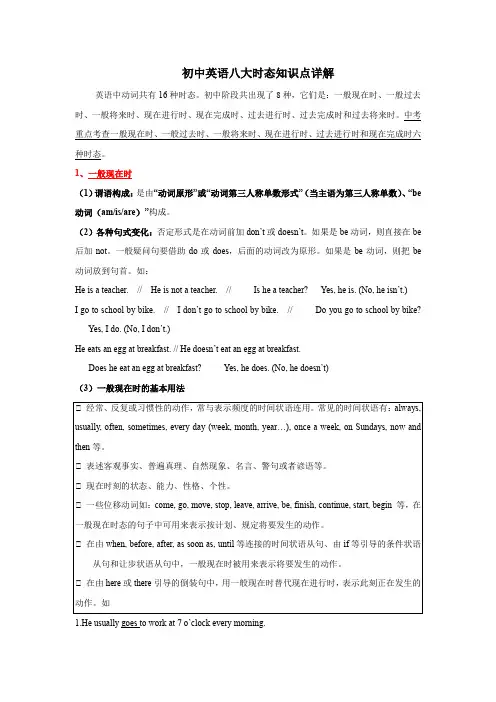
初中英语八大时态知识点详解英语中动词共有16种时态。
初中阶段共出现了8种,它们是:一般现在时、一般过去时、一般将来时、现在进行时、现在完成时、过去进行时、过去完成时和过去将来时。
中考重点考查一般现在时、一般过去时、一般将来时、现在进行时、过去进行时和现在完成时六种时态。
1、一般现在时(1)谓语构成:是由“动词原形”或“动词第三人称单数形式”(当主语为第三人称单数)、“be 动词(am/is/are)”构成。
(2)各种句式变化:否定形式是在动词前加don’t或doesn’t。
如果是be动词,则直接在be 后加not。
一般疑问句要借助do或does,后面的动词改为原形。
如果是be动词,则把be 动词放到句首。
如:He is a teacher. // He is not a teacher. // ---- Is he a teacher? --- Yes, he is. (No, he isn’t.)I go to school by bike. // I don’t go to school by bike. // ---- Do you go to school by bike? ---- Yes, I do. (No, I don’t.)He eats an egg at breakfast. // He doesn’t eat an egg at breakfast.---- Does he eat an egg at breakfast? ---- Yes, he does. (No, he doesn’t)(3)一般现在时的基本用法1.He usually goes to work at 7 o’clock every morning.2.Every dog has its day. 凡人皆有得意日。
3.Pride goes before a fall. 骄者必败。
4.The earth goes around the sun. 地球绕着太阳转。
初中英语语法八大时态总结(完整版)
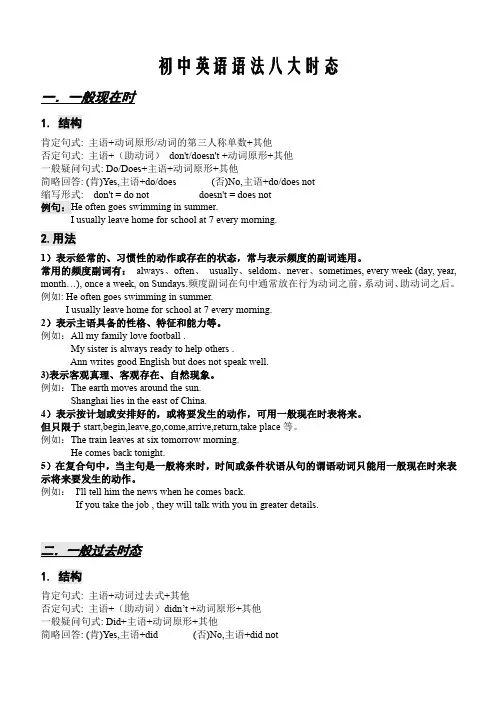
初中英语语法八大时态一.一般现在时1. 结构肯定句式: 主语+动词原形/动词的第三人称单数+其他 否定句式: 主语+(助动词) don't/doesn't +动词原形+其他 一般疑问句式: Do/Does+主语+动词原形+其他 简略回答: (肯)Yes,主语+do/does (否)No,主语+do/does not 缩写形式: don't = do not doesn't = does not 例句:He often goes swimming in summer. I usually leave home for school at 7 every morning.2.用法1)表示经常的、习惯性的动作或存在的状态,常与表示频度的副词连用。
常用的频度副词有: always、often、 usually、seldom、never、sometimes, every week (day, year, month…), once a week, on Sundays.频度副词在句中通常放在行为动词之前, 系动词、 助动词之后。
例如: He often goes swimming in summer. I usually leave home for school at 7 every morning. 2)表示主语具备的性格、特征和能力等。
例如:All my family love football . My sister is always ready to help others . Ann writes good English but does not speak well. 3)表示客观真理、客观存在、自然现象。
例如:The earth moves around the sun. Shanghai lies in the east of China. 4)表示按计划或安排好的,或将要发生的动作,可用一般现在时表将来。
初中英语八种时态详解
初中英语八种时态详解一.一般现在时一.要点提示一般现在时主要用动词原形表示,但是当主语是第三人称单数或者单数名词时,动词的形式要发生变化,其变化规律是:1. 一般动词后加-s, 如:wears, reads, plays, likes, 2.以s, x, ch, sh结尾,后加-es, 如:watches, brushes, 3.以辅音字母+o结尾,一般加-es, 如:goes, does, 4.辅音字母+y 结尾,变y为i,再加-es, 如:worries, carries. Be动词一般现在时的特殊形态是:am, is, are。
Have的第三人称单数是has。
二.用法指南一般现在时的用法1) 表示经常性或习惯性的动作,常与表示频度的时间状语连用。
时间状语:always总是, often经常,usually通常, seldom很少, never从不, sometimes有时(以上频度副词位置放于行为动词之前), every…每…(放于句首或者句末均可)I leave home for school at 7 every morning.It often snows here.2) 表示现在的状态、特征、能力、性格等。
I know him very well.Ann Wang writes good English but does not speak well.3) 表示格言或警句中。
Pride goes before a fall. 骄者必败。
Failure is the mother of success. 失败是成功之母。
4) 表示客观真理,客观存在,科学事实。
The earth moves around the sun.Shanghai lies in the east of China.三. 一般现在时态的肯定形式,否定形式及疑问形式肯定形式是用动词原形,be动词用am, is, are, 注:动词的第三人称单数形式的变化;否定形式是在be动词后加否定词not(缩写成isn’t, aren’t, am与not不能缩写),或者添加助动词do/does加not再加动词原形(缩写成don’t/doesn’t).疑问形式是把be动词或助动词do/does提置句首, 动词还原,句末问号,人称上第一人称变第二人称,第二人称变第一人称,第三人称不变。
(完整版)初中英语八大时态语态总复习时态讲解.docx
初中英语八大时态语态总复习时态讲解一般现在时态【展示平台】1 一般现在时态用来表示经常,反复,习惯性发生的动作或存在的状态,常与表示频率的副词 sometimes(有时) , often(经常), usually(通常), always (总是)等连用。
时间状语in the morning/ afternoon/ evening(在上午/下午 / 晚上) , every day/ week/ month/ year(每天/周/月/年, at noon/night (在中午 / 夜里) , on Monday/Tuesday (在星期一 / 二)等也可用在一般现在时态中。
如:Bruce usually walks to school.We have two P.E classes every week.布鲁斯通常步行去上学。
我们每周上两节体育课。
2 表示现在的特征或状态。
如:She is always ready to help others.He is 13 years old. 他 13 岁了。
她总是乐于助人。
3表示事实或客观真理,或在谚语中,也用一般现在时。
如:The sun rises in the east and sets in the west every day.太阳每天东升西落。
When there is a will, there is a way.有志者,事竟成。
4一般现在时的基本句型1)肯定句:①主语+动词原形+其他②主语(第三人称单数)+ 动词 -s+ 其他如: They live in China.他们住在中国。
He likes eating apples.他喜欢吃苹果。
2)否定句:①主语+don’t+动词原形+其他②主语(第三人称单数) +doesn’t+ 动词原形如: They don ’t live in China.他们不住在中国。
He doesn’t like eating apples.他不喜欢吃苹果。
归纳总结初中时八大时态
归纳总结初中时八大时态初中英语学习中,时态是一个重要的知识点,掌握好不同时态的用法对于准确地表达自己的意思非常关键。
在初中的英语学习中,我们学习了八大时态,分别是一般现在时、一般过去时、一般将来时、现在进行时、过去进行时、将来进行时、现在完成时和过去完成时。
下面对这八个时态进行归纳总结,帮助大家更好地掌握和运用。
一、一般现在时 (Simple Present Tense)这个时态用来描述现在经常或习惯性发生的动作,也用于陈述客观事实以及经常性的真理。
例如:I play basketball every afternoon. (我每天下午打篮球)Water boils at 100 degrees Celsius. (水在100℃时沸腾)他们通常通过一起出去玩来放松自己。
(They usually relax themselves by going out together.)二、一般过去时 (Simple Past Tense)一般过去时用来描述在过去某个时间发生的动作或存在的状态。
例如:I watched a movie last night. (昨晚我看了一部电影)He lived in London for five years. (他在伦敦住了五年)我们在学校门口等了你很长时间。
(We waited for you for a long time at the school gate.)三、一般将来时 (Simple Future Tense)一般将来时用来表示将来会发生的动作或存在的状态。
例如:I will go shopping tomorrow. (我明天会去购物)She is going to visit her grandparents next month. (她下个月要去看望她的祖父母)我们将在周末举办一场聚会。
(We will have a party this weekend.)四、现在进行时 (Present Continuous Tense)现在进行时用来表示现在正在进行的动作或事情。
初中英语八大时态讲解
初中英语八大时态讲解英语中,时态是英语语法中重要的组成部分,它表示的是在某个时间段内动作的状态。
初中英语中,时态主要包括八大时态,分别是:一般现在时、一般过去时、一般将来时、过去将来时、现在进行时、过去进行时、现在完成时和过去完成时。
一、一般现在时一般现在时表示的是经常性或习惯性的动作或状态,也可以表示现在的状态或特征。
例如,“I eat breakfast every morning.”这句话中,“eat”这个动作就是经常性的动作,所以使用一般现在时。
二、一般过去时一般过去时表示过去某个时间发生的事情或存在的状态。
例如,“I went to the park yesterday.”这句话中,“went”这个动作发生在过去,所以使用一般过去时。
三、一般将来时一般将来时表示将来某个时间要发生的动作或存在的状态。
例如,“I will go to the park tomorrow.”这句话中,“go”这个动作将在明天发生,所以使用一般将来时。
四、过去将来时过去将来时表示从过去某个时间看,将要发生的动作或存在的状态。
例如,“He said he would go to the park.”这句话中,“he”认为“he would go to the park”是未来要发生的事情,所以使用过去将来时。
五、现在进行时现在进行时表示正在进行的动作或存在的状态。
例如,“I am eating an apple.”这句话中,“eating”这个动作正在进行,所以使用现在进行时。
六、过去进行时过去进行时表示过去某个时间正在进行的动作或存在的状态。
例如,“She said she was watching TV at 8 o’clock last night.”这句话中,“watching TV”这个动作在昨晚8点正在进行,所以使用过去进行时。
七、现在完成时现在完成时表示过去发生的动作对现在造成的影响或结果,也可以表示持续到现在的动作或状态。
- 1、下载文档前请自行甄别文档内容的完整性,平台不提供额外的编辑、内容补充、找答案等附加服务。
- 2、"仅部分预览"的文档,不可在线预览部分如存在完整性等问题,可反馈申请退款(可完整预览的文档不适用该条件!)。
- 3、如文档侵犯您的权益,请联系客服反馈,我们会尽快为您处理(人工客服工作时间:9:00-18:30)。
初中英语八大时态语态总复习时态讲解一般现在时态【展示平台】1 一般现在时态用来表示经常,反复,习惯性发生的动作或存在的状态,常与表示频率的副词sometimes(有时), often(经常), usually(通常), always (总是)等连用。
时间状语in the morning/ afternoon/ evening(在上午/下午/晚上), every day/ week/ month/ year(每天/周/月/年, at noon/night (在中午/夜里), on Monday/Tuesday(在星期一/二)等也可用在一般现在时态中。
如:Bruce usually walks to school. 布鲁斯通常步行去上学。
We have two P.E classes every week. 我们每周上两节体育课。
2 表示现在的特征或状态。
如:She is always ready to help others. 她总是乐于助人。
He is 13 years old. 他13岁了。
3 表示事实或客观真理,或在谚语中,也用一般现在时。
如:The sun rises in the east and sets in the west every day. 太阳每天东升西落。
When there is a will, there is a way. 有志者,事竟成。
4 一般现在时的基本句型1)肯定句:① 主语+动词原形+其他②主语(第三人称单数)+ 动词-s+ 其他如:They live in China. 他们住在中国。
He likes eating apples. 他喜欢吃苹果。
2)否定句:① 主语+don’t+ 动词原形+其他② 主语(第三人称单数)+doesn’t+ 动词原形+其他如:They don’t live in China. 他们不住在中国。
He doesn’t like eating apples. 他不喜欢吃苹果。
3)一般疑问句:① Do+主语+动词原形+其他?② Does+主语(第三人称单数)+ 动词原形+其他?如:Do they live in China? 他们住在中国吗?Does he like eating apples? 他喜欢吃苹果吗?【相关链接】当主语是第三人称单数时,谓语动词用第三人称的单数形式。
谓语动词的第三人称单数形式的变化规则如下:1)一般在动词后直接加s。
如:talk –talks, live –lives。
2)以s, x., ch, sh或o结尾的动词在其后加es。
如: watch –watches, wash –washes, go –goes。
3)以辅音字母加y结尾的动词,把y变成i再加es。
如: carry – carries, fly –flies。
4)特殊的,如:have的第三人称单数为has。
【牵手中考】1. Bob often ______his mother with the housework on SundaysA. helpB. helpingC. helpsD. helped【解析】根据题中的时间状语often和on Sundays 可判断该句应用一般现在时态。
主语Bob是第三人称单数,所以谓语动词也应为单数加s,故选C。
2. —What did the teacher say just now?—He said that the earth ________ round the sun. (福州)A. goB. goesC. wentD. will goII. 用所给动词的适当形式填空:1.I ________(write) to you as soon as I _______(get) to London.2. He doean’t feel well and ____________(not eat) any food this morning.3. He ______ not _______(see) me come in, for he ___________(read) something with great interest.9. What ______ your mother _______(do) at eight yesterday evening? She _______( wash) clothes.15. Will you come if he _____________ (not come)?19. I don’t know if Mr.Wang ______ (go) to Shanghai tomorrow. If he _____ (go), I _ _____ (ask) him _______ (take) some books to my daughter, because she _______ (st udy) there.III单项选择:1.The students will go to the Summer Palace if it _____ tomorrow.A.don’t rainB. doesn’t rainC. won’t rain2. There _____ an English film next week.A. will haveB. is going to haveC. is going to beD. was going to be5. They _____ the office at nine yesterday morning.A. reached toB. arrivedC. wentD. get to6. We shall go to Shanghai on business before you _____ back next week.A. wil comeB. cameC. would comeD. come7. Don’t smoke until the plane ______ off.A.takesB.tookC.was takenD.is take8. I saw her ____ the room this morning.A.to enterB. enteredC. enterD. enters10. John is always ______ others.A. helpB. helpingC. helpsD. to help二、一般过去时:概念:过去某个时间里发生的动作或状态;过去习惯性、经常性的动作、行为。
时间状语:ago, yesterday, the day before y esterday, last week(year, night, month…), in 1989, just now, at the age of 5, one day, long long ago, once upon a time, etc.基本结构:①be动词;②行为动词否定形式:①was/were+not;②在行为动词前加didn't,同时还原行为动词。
一般疑问句:①was或were放于句首;②用助动词do的过去式did 提问,同时还原行为动词。
1 一般过去时态场用来表示过去某个时间发生的动作或存在的状态。
常用时间状语有:yesterday(昨天), last night(昨晚), last week(上个星期), fourdays ago(四天前), in 2002(在2002年), just now(刚才), the day before yesterday(前天)。
如:He went to the park yesterday. 她昨天去了公园。
(表示过去某个时间发生的动作)I was ten years old in 2003. 我2003年才10岁。
(表示过去某个时间存在的状态)2 表示过去习惯性的动作也用一般过去时。
此时常和表示频率的副词:always (总是), often(经常), sometimes(有时)等连用。
如:He always went to school early last year. 他去年总是早早上学。
3 表达去世的人所做的事往往也用一般过去时。
如:Ying Zheng was the first king in China. 赢政是中国的第一个皇帝。
4 一般过去时态的构成1)肯定句:主语+动词的过去式+其他如:We enjoyed ourselves in the zoo yesterday. 我们昨天在动物园里玩得很高兴。
2)否定句:主语+didn’t +动词原形+其他如:We didn’t enjoy ourselves in the zoo yesterday. 我们昨天在动物园里玩得不高兴。
3)一般疑问句:Did +主语+动词原形+其他如:Did you enjoy yourselves in the zoo yesterday? 你们昨天在动物园里玩得高兴吗?【相关链接】在一般过去时态中会涉及到动词的过去式,大家要掌握规则动词的过去式的变化规则。
变化规则如下:1)一般情况下,在动词原形后直接ed 。
如:play –played , look –looked 。
2)以e结尾的动词在其后加d。
如:like –liked, use –used。
3)与辅音字母加y结尾的动词,把y变成i 再加ed。
如:carry –carried, marry - married。
4)以重读闭音节(或r音节)结尾,末尾只有一个辅音字母时,双写这个辅音字母,再加ed。
如: stop –stopped, prefer –preferred。
当然,刚才提到的都是规则动词的构成,我们还学过许多不规则动词的过去式形式。
如:put –put, see –saw, eat –ate等,这些可需要我们在课下牢牢记住哟!【牵手中考】1.What ______ to her yesterday evening?A. was happenedB. happenedC. happeningD. happen2. —Hi, Kate. You look tired. What’s the matter?—I________ well last night.A. didn’t sleepB. don’t sleepC. hasn’t sleptD. won’t sleep3. —When ____ you _____ your old friends?—The day before yesterday.A. will; visitB. did; visitC. / ; visitD. have; visited三、用所给动词的适当形式填空。
